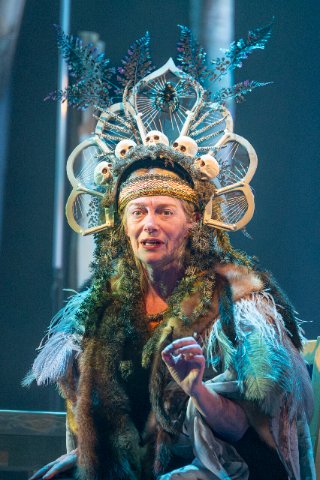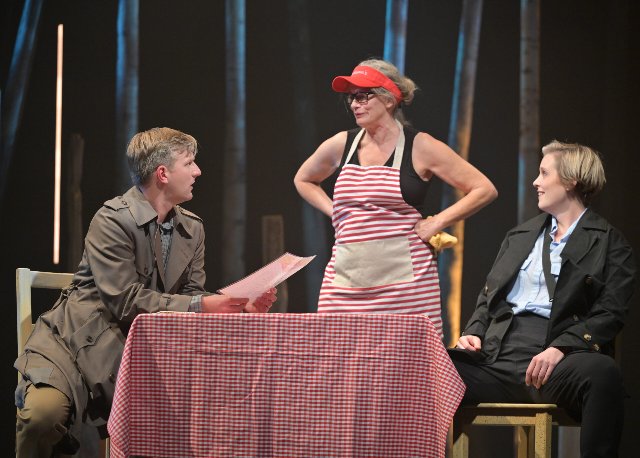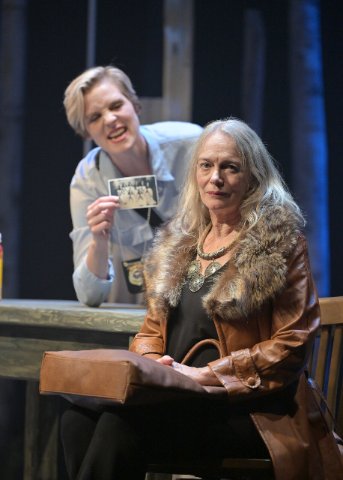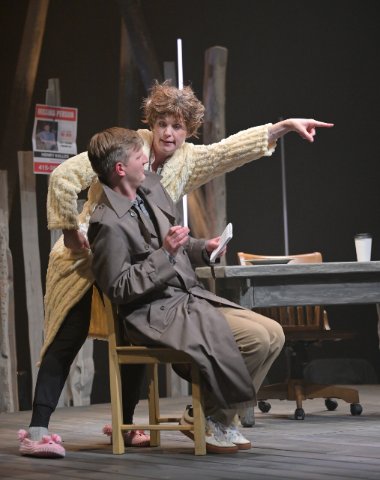Yaga
Marin Theatre's U.S. Premiere of Multi-genre Play
By: Victor Cordell - Oct 17, 2024
The Slavic folklore cultures of Eastern Europe have long been a gushing font for tales of lurid, preternatural beings such as vampires and witches. Perhaps the most ubiquitous are the variations of the Baba Yaga, with baba meaning grandmother or old woman, and yaga being etymologically diverse, but generally construed as a witch. While differing in detail, the Baba Yaga usually appears as a disheveled hag. Her representations reached high culture in Mussorgsky’s orchestral composition Pictures at an Exhibition and in the form of Ježibaba in Dvorák’s Czech opera Rusalka, and low culture in Keanu Reeves’ John Wick movie series as the nickname of the title character.
Marin Theatre has produced the U.S. premiere of Canadian playwright Kat Sandler’s Yaga, an homage to the ambiguous but powerful exemplar. The lore is updated to the contemporary period, taking place in a rural town in an unspecified part of North America. Validating the social isolation of the subject, the play opens with a Baba Yaga asking “Who could love such a person?” But the folk element of the play integrates into another literary genre, the detective mystery. A young man is missing and presumed dead and probably murdered. The wealthy victim’s family, dissatisfied with the police investigation, hires a private detective to pursue the case. Oh, and by the way, this is a comedy – some might say a farce.
Charlie Rapp (Adam KuveNiemann) is a caricature of a private investigator in a comedy – bumptious, full of fast-talking bravado, and dismissive of the public police. But he does need help, and he leans heavily on Police Detective Carson (Rachel Clausen), who is a nice one to lean on, because he finds her informed and very appealing.
That leads to the third main character, Professor Katherine Yazov (Julia McNeal), who becomes a suspect. She attracts attention being an anthropologist who is familiar with the processes to make a body disappear. The alluring but older professor, who is known sub-rosa as the “bone (or boner!) beast” is also uninhibited. Her repartee can be quite explicit and enticing, and she has an appetite for young men, including Henry, the disappeared heir. Yazov comes from a Slavic background, with an elderly mother, Irene, who seems to have traits that might be associated with witchcraft, which include providing unusual drugs to seekers.
The play calls for 14 roles, and you have already been introduced to all of the actors. The three hander is an acting showcase. As specified by the playwright, the male plays two parts, and the women have six each. Kudos to the actors. With pretty minimal costume and hair changes, they do an exemplary job of differentiating the parts that they play by movement, facial expression, and speech patterns.
This conceit of minimizing the number of players would also have placed pressure on the playwright, as two or more characters played by any one actor cannot appear on the stage at the same time, but Sandler managed that challenge effectively. Meg Neville’s costumery facilitates the needed fast switchover of scenes, presumably emphasizing layered and tearaway outfits.
The narrative consists of a myriad of short scenes that advance the investigation with interrogations of several local rubes – all female; elaboration on the main characters and their relationships; and the integration of witchcraft, including a need for breeding and a little faux violence. While Director Barbara Damashek ensures that the frequent scene change device results in fast pacing even when the content drags, the many shifts in direction can also lead to confusion, especially if a patron misses some dialog or when the logic of the action is not immediately clear. Flashbacks add another layer of potential complication.
While the storyline acts as a who-dunnit?, a deeper meaning prevails concerning female empowerment. Men have always written history, and exerting their power, they have inordinately scapegoated women for the wrongs in the world – from Eve in the Bible through the Salem “witches” in colonial Massachusetts. Yet, in some ways, Baba Yaga represents proto-feminism as a fearsome, powerful woman who does not have to depend on good looks or womanly wiles to succeed.
All of the elements of the production are superb. In addition to exemplary acting, Carlos Aceves’ set provides an attractive birch forest backdrop and a forestage that is versatile enough to represent, somewhat in the abstract, everything from a police station to a motel to a diner. Kurt Landesman’s lighting appeals aesthetically and directs the eye, while Matt Stines’ thoughtful sound design ranges from understated background to bombastic on the edges. The recurring musical strands of Santo and Johnny’s wonderful instrumental Sleepwalk have thematic implications.
The inventive script largely entertains with the twists and turns expected in a noir mystery, along with humor and a surprise ending. But despite the admirable strengths of the production, many theatergoers will not find Yaga to be their cup of tea. More tolerance is required to come down in favor.
In addition to the concerns already expressed, the run time is almost three hours, which even advocates should agree is taxing for the type of play that it is. Serious editing would simplify the throughline and reduce the number of less entertaining patches. Also, the audience will divide on language and suggestion. Particularly, some Boomers will consider the explicit language and discussion of sex acts to be vulgar and gratuitous, while many Millennials at the other extreme may find it quite routine.
Yaga, written by Kat Sandler, is produced by Marin Theatre and plays on its stage at 397 Miller Avenue, Mill Valley, CA through November 3, 2024.






